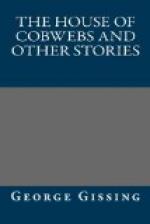The compulsion of the twin monsters Bread and Cheese forced him to write novels the scene of which was laid in the one milieu he had thoroughly observed, that of either utterly hideous or shabby genteel squalor in London. He gradually obtained a rare mastery in the delineation of his unlovely mise en scene. He gradually created a small public who read eagerly everything that came from his pen, despite his economy of material (even of ideas), and despite the repetition to which a natural tendency was increased by compulsory over-production. In all his best books we have evidence of the savage and ironical delight with which he depicted to the shadow of a hair the sordid and vulgar elements by which he had been so cruelly depressed. The aesthetic observer who wanted material for a picture of the blank desolation and ugliness of modern city life could find no better substratum than in the works of George Gissing. Many of his descriptions of typical London scenes in Lambeth Walk, Clerkenwell, or Judd Street, for instance, are the work of a detached, remorseless, photographic artist realising that ugly sordidness of daily life to which the ordinary observer becomes in the course of time as completely habituated as he does to the smoke-laden air. To a cognate sentiment of revolt I attribute that excessive deference to scholarship and refinement which leads him in so many novels to treat these desirable attributes as if they were ends and objects of life in themselves. It has also misled him but too often into depicting a world of suicides, ignoring or overlooking a secret hobby, or passion, or chimaera which is the one thing that renders existence endurable to so many of the waifs and strays of life. He takes existence sadly—too sadly, it may well be; but his drabs and greys provide an atmosphere that is almost inseparable to some of us from our gaunt London streets. In Farringdon Road, for example, I look up instinctively to the expressionless upper windows where Mr. Luckworth Crewe spreads his baits for intending advertisers. A tram ride through Clerkenwell and its leagues of dreary, inhospitable brickwork will take you through the heart of a region where Clem Peckover, Pennyloaf Candy, and Totty Nancarrow are multiplied rather than varied since they were first depicted by George Gissing. As for the British Museum, it is peopled to this day by characters from New Grub Street.
There may be a perceptible lack of virility, a fluctuating vagueness of outline about the characterisation of some of his men. In his treatment of crowds, in his description of a mob, personified as ’some huge beast purring to itself in stupid contentment,’ he can have few rivals. In tracing the influence of women over his heroes he evinces no common subtlety; it is here probably that he is at his best. The odor di femmina, to use a phrase of Don Giovanni’s, is a marked characteristic of his books. Of the kisses—
’by hopeless
fancy feigned
On lips that are for others’—




